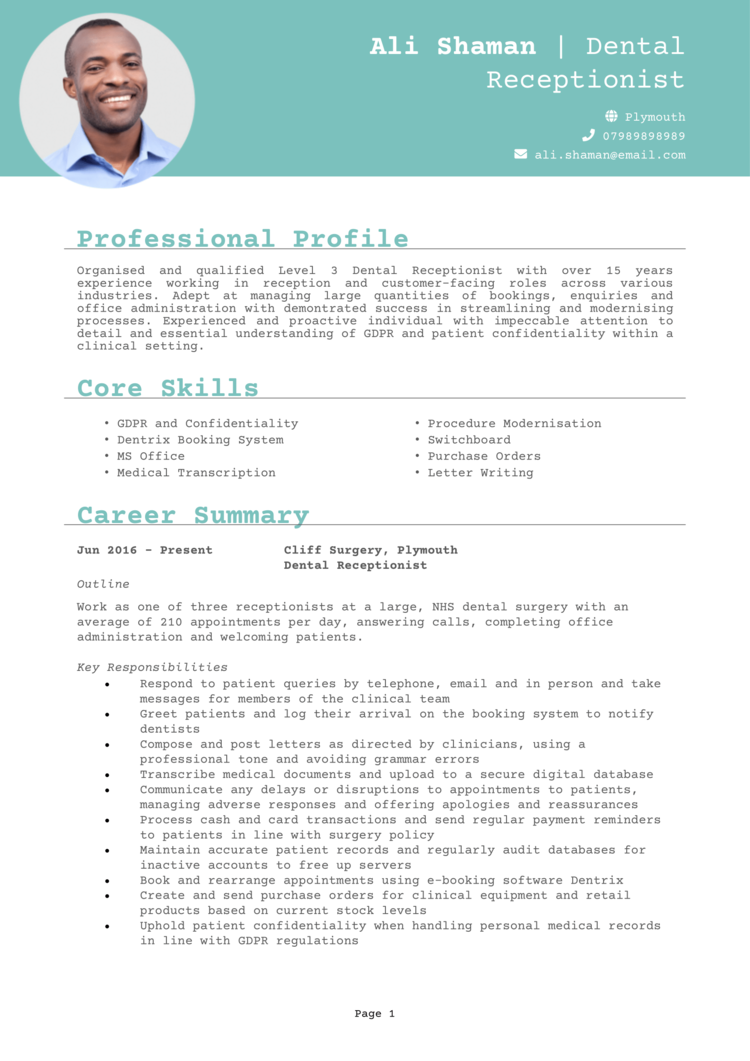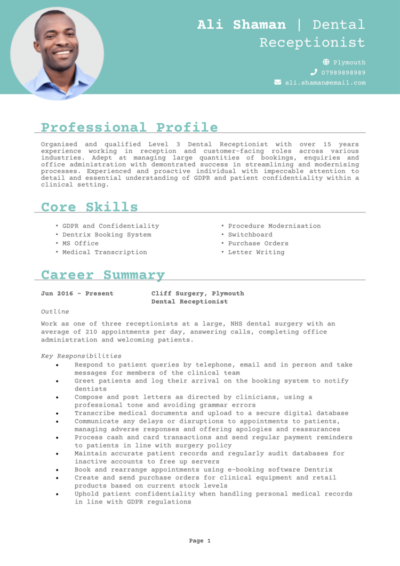You’ve juggled schedules and kept the front desk running smoothly – all without losing your cool (or your smile). But when it comes to writing your CV? That’s where many dental receptionists grind their teeth.
This guide and its Dental Receptionist CV example will show you how to put your communication skills and admin experience into words that get the interviews you deserve for the roles you want.
Dental Receptionist CV sample

How to write your Dental Receptionist CV
Discover how to craft a winning Dental Receptionist CV that lands interviews with this simple step-by-step guide.
A good Dental Receptionist CV does more than list your duties – it shows that you’re the friendly and capable professional every practice needs at the front desk.
From greeting patients and managing bookings to handling payments and ensuring compliance, you’re the first impression and often the person who keeps the day running. This guide walks you through writing a CV which proves that.
What’s the right way to structure and format your Dental Receptionist CV?


Messy CVs are like overbooked calendars – nobody wants to deal with them. Being a receptionist means thinking clearly and staying organised, so your CV structure should show you understand that. When a hiring manager glances at your application, they should be able to pick out your qualifications, skills, and experience within seconds.
Here’s the layout to follow:
- Name and contact details – Place your name and personal details prominently at the top of your CV for quick access. Adding a photo is up to you.
- Profile – Open with a compelling overview of your skills, experience, and career goals.
- Core skills – List your key abilities in this section, focusing on those that will be most relevant to the job.
- Work experience – Provide a detailed breakdown of your work history, starting with the most recent job first.
- Education – List your qualifications, including degrees and relevant certifications, in reverse chronological order.
- Additional info – Use this optional space for relevant hobbies or personal pursuits that enhance your application.
Navigating through your CV’s format shouldn’t be like pulling teeth. Keep your CV clean and simple: use bullet points to break down dense text, bold headings to divide sections, and a clear, professional font to keep it legible. Avoid clutter – a crowded CV is just as off-putting as a chaotic waiting room. And make sure it stays under two pages in length – long enough to show your strengths, short enough to respect the reader’s time.
How to create a Dental Receptionist CV profile


Your professional profile is the welcome message of your CV – it should reflect your customer-facing confidence and organisational know-how, all in a short paragraph. Use it to summarise your experience, outline the kind of dental environments you’ve worked in, and express the benefit you bring to a team.
You need to convince recruiters that you can do the job, and keep patients feeling at ease while you‘re doing it: your CV profile should accomplish that in just a few lines.
Dental Receptionist CV profile examples
Profile 1
Experienced Dental Receptionist with over eight years supporting busy NHS and private dental clinics. Skilled in appointment scheduling, patient communication, and front-desk coordination. Proficient in dental software such as SOE and Dentally, with a strong focus on patient care and practice efficiency.
Profile 2
Reliable Dental Receptionist with six years of experience providing administrative support in mixed dental practices. Confident handling patient queries, managing diaries for multiple clinicians, and processing payments. Known for professionalism, accuracy, and calm communication under pressure.
Profile 3
Organised Dental Receptionist with four years of experience across general dentistry and orthodontics. Experienced in booking appointments, verifying patient records, and supporting CQC compliance. Friendly and approachable, with a focus on creating a welcoming environment for patients of all ages.
Details to put in your Dental Receptionist CV profile
Include the following:
- Where you worked – Briefly mention the types of practices or clinics you’ve supported – private, NHS, specialist, or high-volume dental centres.
- Your top qualifications – If you’ve taken dental reception or administration courses, mention them here.
- Essential skills – Highlight your strengths in patient care, appointment scheduling, admin systems, and front desk management.
- Software knowledge – Note any experience with dental practice software or booking systems.
- Value delivered – Emphasise how your presence helps practices run smoothly, improve patient experience, or support clinical staff.
Presenting your core skills


This section offers a quick glance at your most relevant strengths – think of it as a receptionist’s cheat sheet for the recruiter. Focus on practical, role-specific skills that are directly relevant to the dental environment.
That includes things like diary management, handling patient records, operating dental software, processing payments, and maintaining compliance logs. No need for filler – stick to skills that show you can run the desk, not just sit at it., so avoid vague descriptors – recruiters are looking for clear, job-ready capabilities they can match to their clinic’s needs.
Essential skills that recruiters look for in a Dental Receptionist CV
- Appointment Scheduling and Calendar Management – Booking, rescheduling, and coordinating patient appointments using dental practice management software.
- Patient Records and Data Entry – Maintaining accurate and up-to-date digital and paper records, including medical histories and treatment notes.
- Front Desk Reception and Greeting – Welcoming patients professionally, checking them in, and managing waiting room flow.
- Billing and Payment Processing – Handling payments, issuing invoices, and processing insurance claims or NHS forms accurately.
- Telephone and Email Communication – Answering queries, confirming appointments, and providing information via phone and email.
- Dental Software Proficiency – Using systems like SOE, Dentrix, or R4 to manage appointments, records, and administrative tasks.
- Compliance with Data Protection and Confidentiality – Ensuring patient data is handled securely in line with GDPR and clinical confidentiality standards.
- Liaison with Dental Team – Coordinating with dentists, hygienists, and nurses to ensure smooth daily operations and effective communication.
- Stock and Supply Coordination – Assisting with ordering and tracking front-desk supplies and supporting clinical inventory requests when required.
- Patient Experience and Service Support – Creating a positive first impression, answering questions about treatments or procedures, and helping nervous patients feel at ease.
How to highlight work experience


Your work experience section should give a clear picture of the types of practices you’ve worked in, the duties you’ve carried out, and the pace or complexity of the environment. Whether you’re managing a busy phone line or calmly dealing with a delayed appointment and a full waiting room, this is where you show what you’ve handled – and how.
List your roles in reverse order, starting with your most recent. For each job, begin with a short summary describing the workplace and your overall responsibilities. Then use bullet points to list your specific duties and achievements. Focus on how you kept things running smoothly, maintained records accurately, and contributed to positive patient experiences.
How to make your past experience easy to read for employers

- Outline – Briefly describe the dental practice and your role in it. Mention the volume of patients, size of the team, or type of services offered.
- Responsibilities – Use action words like “managed” and “coordinated.” For example: “managed daily appointment schedules using EXACT software” or “coordinated between dentists, hygienists, and patients to ensure smooth clinic flow.”
- Achievements – Highlight how you improved service delivery – such as streamlining appointment booking, increasing patient satisfaction, or helping maintain compliance records.
Example job entries for Dental Receptionist
Dental Receptionist | Willowbank Dental Practice
Outline
Managed front-of-house operations for a busy four-chair NHS dental practice, ensuring smooth patient flow and professional communication.
Responsibilities
- Booked appointments and managed diaries for five clinicians
- Welcomed patients, handled registration forms, and updated records
- Processed NHS claims and handled payments via cash and card
- Answered phone calls and emails, addressing appointment queries and cancellations
- Maintained patient confidentiality and supported GDPR compliance
Achievements
- Reduced appointment no-shows by 25% by introducing reminder calls
- Praised in patient feedback surveys for professionalism and helpful attitude
- Supported smooth delivery of three CQC inspections with accurate documentation
Dental Receptionist | Elmwood Orthodontic Centre
Outline
Provided reception and administrative support in a private orthodontic practice serving both adult and paediatric patients.
Responsibilities
- Scheduled consultation and follow-up appointments across multiple treatment stages
- Filed X-rays, consent forms, and referrals into patient management system
- Coordinated with dental nurses and treatment coordinators to optimise clinic flow
- Maintained supply records and placed weekly orders for front-desk materials
- Handled sensitive conversations with nervous patients and parents
Achievements
- Helped increase patient retention by improving clarity of appointment communications
- Created a new welcome pack that improved patient onboarding feedback
- Trained two new hires on reception protocols and software
Dental Receptionist | Harborough Smile Studio
Outline
Supported reception and admin tasks in a modern cosmetic dental clinic, focusing on private treatments and high-end client care.
Responsibilities
- Booked consultations, cosmetic procedures, and hygiene appointments
- Processed payments, issued invoices, and reconciled end-of-day balances
- Provided pre-treatment information and answered patient questions
- Updated patient notes and contact details in SOE system
- Ensured waiting area and reception remained clean, stocked, and welcoming
Achievements
- Maintained 100% booking accuracy across a three-month promotion period
- Recognised by management for consistently positive patient feedback
- Assisted in improving clinic’s online reviews through excellent customer care
Education and qualifications


While formal education isn’t always the deciding factor in this role, your CV should still include your academic background – especially if you’ve taken any admin or dental reception training. Start with your most recent qualification and work backward.
Include any professional development courses, particularly those related to medical or dental admin.
Qualifications recruiters look for in a Dental Receptionist
- Dental Receptionist Diploma (City & Guilds) – Offers practical training in front desk skills specific to dental environments
- Level 2 or 3 NVQ in Business and Administration – Demonstrates admin competency relevant to reception duties
- Certificate in Dental Practice Management – Useful if you’ve supported or stepped into management duties
- First Aid at Work Certificate – Valuable in patient-facing settings
- GCSEs (including English and Maths) – Often required for entry-level receptionist roles





